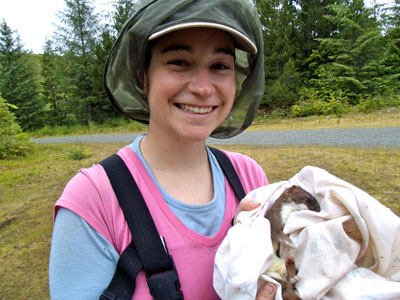
Carolyn Eckrich is a Ph.D. student at the University of Wyoming and is co-advised by Drs. Merav Ben-David and Liz Flaherty. She was the field team leader for the project and is leading the modeling efforts.
Small mammal and small carnivore responses to pre-commercial thinning treatments
Availability of small mammals, including Peromyscus spp., Microtus spp., and Sorex spp., can greatly impact populations of forest indicator and endemic species in the Tongass National Forest (TNF), including northern goshawks (Accipiter gentilis), American martens (Martes americana), and ermine (Mustela erminea). Over the past 60+ years, logging operations on the Tongass National Forest (TNF) converted over 174,000 ha of old-growth conifer forest to young, even-aged stands. Because forest succession in Southeast Alaska is slow, these extensive young-even-aged stands will persist for an extended period of time. We used research treatments established by the Tongass-Wide Young-Growth Studies (TWYGS) on Prince of Wales Island (POW) to assess the effects of different precommercial thinning practices on small mammal populations. Our goal was to ultimately provide suggestions to the US Forest Service on best practices for managing young-growth stands to improve wildlife habitat and increase the liklihood of persistence of sensitive species. After 3 summers of intense field work, our spatially-extensive study has not only yielded important suggestions for forest management in this region but also revelaed a 5-6 year predator-prey cycle. Future work includes development of a 2 predator – 2 prey model that incorporates spatial segregation.
